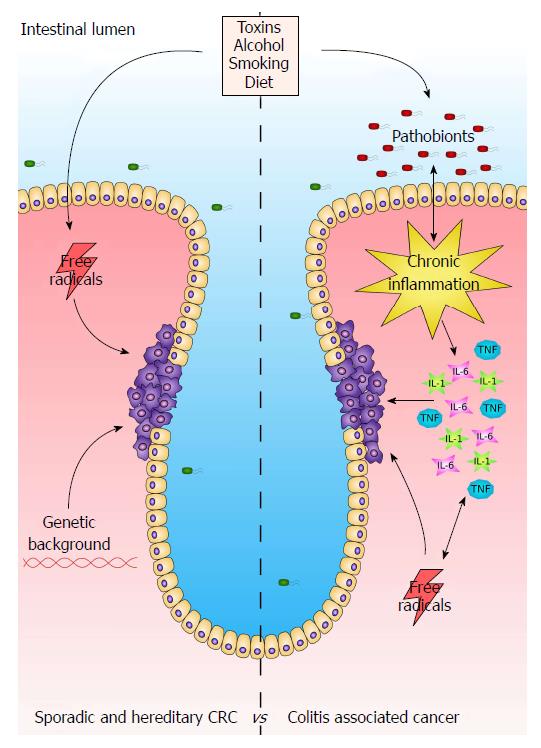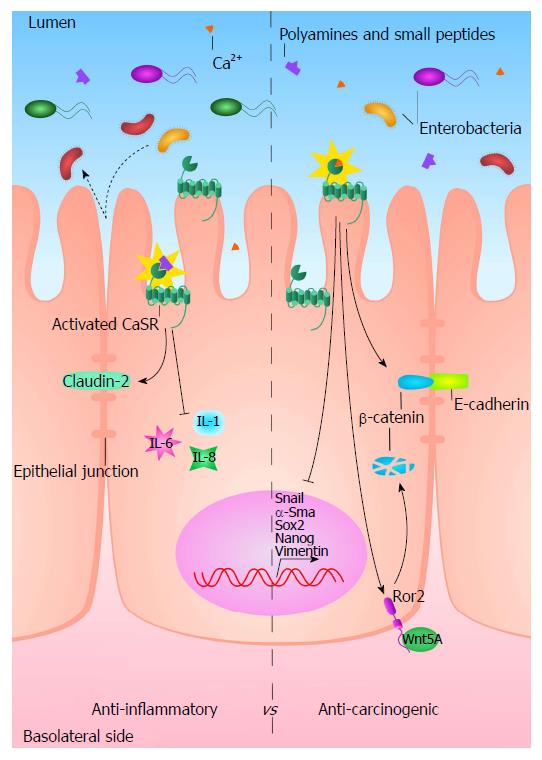Copyright
©The Author(s) 2018.
World J Gastroenterol. Sep 28, 2018; 24(36): 4119-4131
Published online Sep 28, 2018. doi: 10.3748/wjg.v24.i36.4119
Published online Sep 28, 2018. doi: 10.3748/wjg.v24.i36.4119
Figure 1 Scheme of colonic carcinogenesis.
Left: Environmental cues such as toxins, alcohol, smoke and diet can produce free radicals (such as reactive oxygen and nitrogen species) that can damage genomic DNA. Accumulating mutations, in particular in genes that encode for mitogenic, cell cycle or apoptosis factors such as APC, BRAF, KRAS, EGF and p53 can then eventually lead to colon carcinogenesis. Genetic background such as inborn APC mutations (hereditary familial adenomatous polyposis) or other hereditary mutations also predispose towards colon tumourigenesis, although hereditary CRC is rare[81]. Right: In addition to their direct noxious effect on the tissue, environmental cues can also alter the microbiotic population of the intestine, promoting the proliferation of pathogenic bacteria (pathobionts). Pathobionts and chronic inflammation are closely related and both induce the expression of pro-inflammatory cytokines that accumulate in the mucosa. Persistent inflammation interferes with cell proliferation and apoptosis processes leading to tumourigenesis and in particular in colitis associated cancer. Inflammation itself also induces the production of free radicals that hamper genome stability and can thus cause tumour development[82]. TNF: Tumor necrosis factor; IL: Interleukin; CRC: Colorectal cancer.
Figure 2 Protective function of the calcium-sensing receptor against inflammation and carcinogenesis in the colon.
Left: The CaSR promotes intestinal barrier integrity, potentially by promoting claudin-2 expression, and inhibits the expression of pro-inflammatory cytokines, thus preventing inflammation. Right: The CaSR exerts an anti-tumourigenic effect by counteracting the mitogenic Wnt pathway, preventing β-catenin translocation into the nucleus, which is either sequestered by E-cadherin at the cell junctions or it is degraded by the non-canonical Wnt signalling (Ror2-Wnt5A) and inhibits the expression of mesenchymal and stem cells markers. IL: Interleukin; CaSR: Calcium-sensing receptor.
- Citation: Iamartino L, Elajnaf T, Kallay E, Schepelmann M. Calcium-sensing receptor in colorectal inflammation and cancer: Current insights and future perspectives. World J Gastroenterol 2018; 24(36): 4119-4131
- URL: https://www.wjgnet.com/1007-9327/full/v24/i36/4119.htm
- DOI: https://dx.doi.org/10.3748/wjg.v24.i36.4119










